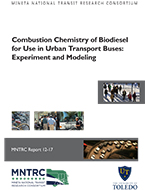Abstract:
Biofuels, such as biodiesel, offer benefits as a possible alternative to conventional fuels due to their fuel source sustainability and reduced environmental impact. Before they can be used, however, it is essential to understand their physical properties, combustion chemistry, and characterization of the exhaust due to a number of issues associated with fuel properties—for example, a lower heating value and higher cloud point than regular diesel. High viscosity of biodiesel may lead to poor atomization of the fuel spray and inaccurate operation of the fuel injectors, so, it may cause fuel injector problems. Biodiesel may produce high NOx emissions. Depending on the feedstocks and blending ratios used to produce the fuel, variations in chemical properties may also be an issue.
During this study, physical properties such as flash point, cloud point, and kinematic viscosity of different blends (B0, B10, B20, B50, and B100) were measured on three different feedstocks (soybean methyl ester or SME, tallow oil, or TO, and waste cooking oil, or WCO) while ultra-low sulfur diesel (ULSD) was used as base fuel. The research applied the standard methods of the American Society for Testing and Materials (ASTM). For the study of combustion chemistry and characterization of the exhaust, various tests, such as gravimetric analysis, elemental analysis, elemental carbon/organic carbon (EC/OC) analysis, and gas chromatography (GC) analysis, were conducted for PM emission samples collected from buses, as well as from the laboratory setup. In the field, emission samples were collected for both hot and cold idle conditions.
Gravimetric analysis showed a decrease of 17% in PM emissions from the transit buses running on B20 compared to ULSD (B0). A total of eleven elements were detected in the exhaust samples collected from the laboratory experiments, and fifteen elements from the field experiments. Calcium (Ca), sodium (Na), and iron (Fe) were the major elements. The results also indicated that the use of biodiesel could effectively reduce EC and increase the portion of OC/EC emissions. Positive matrix factorization (PMF) was used to identify all possible sources of the elements from the transit buses. A simple chemical model was also proposed on PM formation from transit buses, as well as the emission from the laboratory experiments. The emission of carbon was also investigated, and the results confirmed that lower emissions of CO and CO2 are related to lower ratios of carbon to oxygen in biodiesel fuels compared to ULSD.
Publications:
Authors:
ASHOK KUMAR, PH.D.
Dr. Ashok Kumar is a professor and chairman of Civil Engineering at The University of Toledo, Toledo, Ohio. Before coming to Toledo he worked for Syncrude Canada Ltd. as an atmospheric physicist where he developed, planned, and conducted studies related to the dispersion of emissions of a tar sands plant.
Dr. Kumar received his Bachelor of Science in Engineering (Honors) from Aligarh University in India (1970), his Master of Applied Science from University of Ottawa, Canada (1972), and his Ph.D. from the University of Waterloo, Canada (1978). He is registered as a Professional Engineer in the Province of Alberta, Canada and is a Diplomat of the American Academy of Environmental Engineers. He is a fellow member of Air and Waste Management Association (A∓WMA).
Air and Waste Management Association presented him with L. A. Ripperton Award for distinguished achievement as an educator in the field of air pollution control in June 2003. He was conferred honorary membership in A&WMA in 2014. His research work has focused on finding innovative solutions to fundamental and applied problems in air quality, risk analysis, and environmental data analysis. He was a Co-PI on the TARTA grant and a PI on the MIOH grant on the use of alternative fuels.
DONG-SHIK KIM, PH.D.
Dr. Kim is associate professor of Chemical and Environmental Engineering at University of Toledo. Since joined the faculty, Dr. Kim has worked on several research projects supported by Federal, State, and international funding agencies including NSF, NASA, USDA, Air Force, Ohio Board of Regents, and KIST (Korea Institute of Science and Technology).
His research has focused on biomaterials development and biomass energy. Dr. Kim earned his Bachelor of Science and Master of Science degrees in chemical engineering at Seoul National University, Korea, and his doctorate in chemical engineering at the University of Michigan, Ann Arbor. Dr. Kim is an active member of American Institute of Chemical Engineers, American Chemical Society, and American Society of Engineering Education.
Recognized for his achievements in research and education, he received deArce Memorial Endowment Award, Kohler Junior Faculty Award, and Outstanding Undergraduate Research Mentor Award. He is a recipient of Air Force Summer Faculty Research Award in 2010, 2012, and 2013. He has published 40 articles in peer-reviewed journals and presented his work in domestic and international conferences. He received a US Army Achievement Medal in 1987 after 3 years of military service in Korea. He is a registered professional engineer in Michigan.
HAMID OMIDVARBORNA
Hamid Omidvarborna is a Ph.D. student at The University of Toledo. For three years up until 2012, he worked for chemical and petrochemical companies in IRAN as process engineer and QC controller. He received his Bachelor of Science in Chemical Engineering from Razi University (2005) and his Master of Science from Isfahan University of Technology (2008), both in IRAN. His M.Sc. thesis was related to heat transfer enhancement. He is currently involved in the Civil Engineering department at The University of Toledo, and his main research interest is in biofuel combustion chemistry and emission analysis.
SUDHEER KUMAR KUPPILI
Sudheer Kumar Kuppili is a Ph.D. student at The University of Toledo. Sudheer received his Bachelor of Technology in Civil Engineering in 2012 from Chaitanya Engineering College, JNT University, Visakhapatnam, India. He worked as a summer lecturer in 2012 at Chaintanya Engineering College. His work emphasizes biodiesel properties while focusing on the characterization and sensitive analysis of particulate matter and nitrogen oxides released from TARTA buses, which uses biodiesel fuel. He also conducts relative experiments in lab. He has been involved in this project since August 2012.


